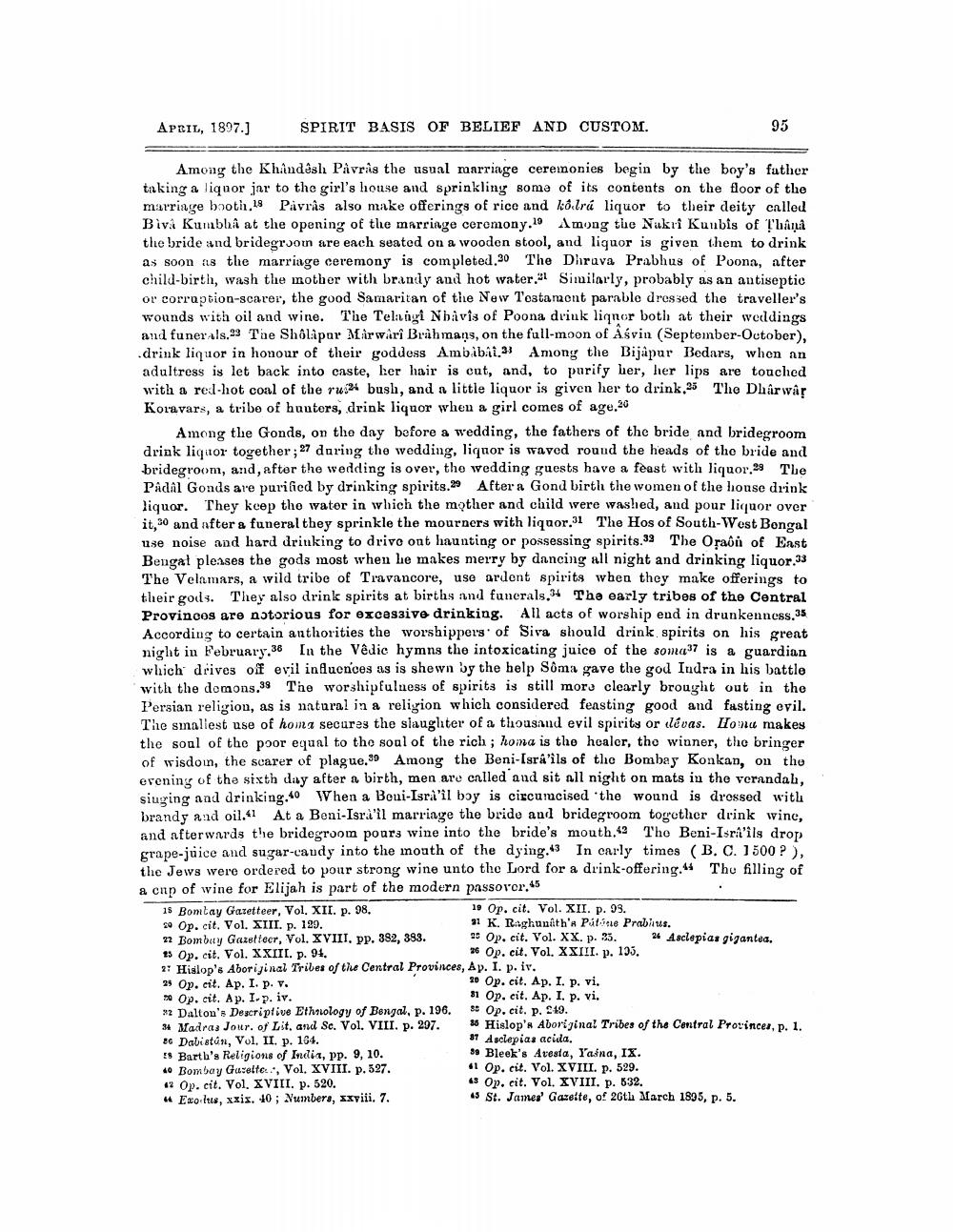________________
APRIL, 1897.)
SPIRIT BASIS OF BELIEF AND CUSTOM.
95
Among the Khandaslı Pavris the usual marriage cereinonies begin by the boy's father taking a liquor jar to the girl's house and sprinkliny some of its contents on the floor of the marriage booth.18 Pavras also make offerings of rice and kålrá liquor to their deity called Biva Kumblâ at the opening of the marriage ceremony.19 Among the Nakri Kuubis of shara the bride and bridegrootn are each seated on a wooden stool, and liquor is given them to drink as soon as the marriage ceremony is completed.30 The Dhruva Prabhus of Poona, after child-birth, wash the mother with brancy and hot water. Similarly, probably as an antiseptic or corruption-scarer, the good Samaritan of the New Testament parable dressed the traveller's wounds with oil and wine. The Telangi Nbavis of Poona driuk liqnor both at their weddings and funerals.23 Tae Sholapar Mirwari Brahmans, on the full-moon of Asvin (September-October), .drink liquor in honour of their goddess Ambibil.33 Among the Bijapur Bedars, when an adultress is let back into caste, her hair is cut, and, to purify her, her lips are touched with a red-hot coal of the rui24 bush, and a little liquor is given her to drink,25 The Dharwar Kolavars, a tribe of hunters, drink liquor when a girl comes of age 20
Among the Gonds, on the day before a wedding, the fathers of the bride and bridegroom drink liquor together; 27 during the wedding, liquor is waved round the heads of the bride and bridegroom, and, after the wedding is over, the wedding guests have a feast with liquor 29 The Padal Gonds are purified by drinking spirits.29 After a Gond birth the women of the lionse drink liquor. They keep the water in which the mother and child were washed, and pour liquor over it, 30 and after a funeral they sprinkle the mourners with liquor.31 The Hos of South-West Bengal use noise and hard drinking to drive ont haunting or possessing spirits.33 The Oraon of East Bengal pleases the gods most when he makes merry by dancing all night and drinking liquor.33 The Velamars, a wild tribe of Travancore, use ardent spirits when they make offerings to their gods. They also drink spirits at births and funerals.34 The early tribes of the Central Provinces are notorious for excessive drinking. All acts of worship end in drunkenness.35 According to certain anthorities the worshippers of Siva should drink spirits on his great might in February.38 In the Vedic hymns the intoxicating juice of the somais a guardian which drives of evil influences as is shewn by the help Soma gave the god Iudra in his battle with the domons,38 The worshipfulness of spirits is still more clearly brought out in the Persian religion, as is natural in a religion which considered feasting good and fasting evil. The sinallest use of homa secure the slaugliter of a thousand evil spirits or clévas. Honu makes the soul of the poor equal to the soul of the rich; homa is the healer, the winner, the bringer of wisdoin, the scarer of plague,39 Among the Beni-Isra'ils of the Bombay Konkan, on the evening of the sixth day after a birth, men are called and sit all night on mats in the verandah, siuging and drinking. When a Beni-Isra'il boy is circumcised the wound is drossed with brands and oil.1 At a Beni-Isra'il marriage the bride and bridegroom together drink winc, and afterwards the bridegroom poars wine into the bride's mouth. Tho Beni-Isra'ils drop grape-juice and sugar-caudy into the inouth of the dying.43 In carly times (B. C. 1500 ?), the Jews were ordered to pour strong wine unto the Lord for a drink-offering." Thu filling of a cnp of wine for Elijah is part of the modern passover.45 15 Bombay Gazetteer, Vol. XII. p. 98.
19 Op. cit. Vol. XII. p. 93. 50 Op. cit. Vol. XIII. p. 129.
31 K. Raghunath's Pútine Prabhus. 22 Bombay Gazetteer, Vol. XVIII. PP. 382, 383. 5 Op. cit. Vol. XX. p. 35. 24 Asclepias gigantea. 15 Op. cit. Vol. XXIII. p. 94.
26 Op. cit. Vol. XXIII. p. 135. 2! Hislop's Aboriginal Tribes of the Central Provinces, Ap. I. p. iv. 25 Op. cit. Ap. I. P. V.
20 Op. cit. Ap. I. p. vi. 50 Op.cit. Ap. I. p. iv.
$1 Op. cit. Ap. I. p. vi. 2 Dalton's Descriptive Ethnology of Bengal, p. 196. $0 Op. cit. p. 249. 34 Madras Jour. of Lit, and Sc. Vol. VIII. p. 297. 36 Hislop's Aboriginal Tribes of the Central Provinces, p. 1. 26 Dabistun, Vol. II. p. 164.
37 Asclepias acida. ! Barth's Religions of India, pp. 9, 10.
39 Bleek's Aresta, Yasna, IX. 40 Bombay Gusette :, Vol. XVIII. p. 527.
+1 Op. cit. Vol. XVIII. p. 529. 12 Op.cit. Vol. XVIII. p. 520.
19 Op. cit. Vol. XVIII, p. 632. * Exotis, xxix. 40; Numbera, xxviii. 7.
45 St. James' Gazeite, of 26th March 1895, p. 5.




